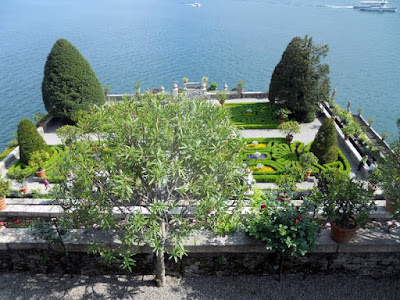Initially little more than a barren and rocky crag in Lago Maggiore, Isola Bella was not at all a promising site for gardens. Work on the gardens began in 1632 and continued for 40 years. As can be expected, it was a gruelling and labor-intensive project. Rocks on the island were levelled off and great quantities of soil were brought over from the mainland so that trees and plants could be sustained there. Where necessary, the gardens were extended on pillars into the lake.
There are ten terraces rising one above the other in diminishing scale that have led to Isola Bella's gardens being compared to the Hanging Gardens of Babylon.
Each terrace is balustraded and heavily garnished with vases and statues.
They make Isola Bella resemble an ornate many-decked flower-laden ship. Here is its prow, seen from above.
And here it is viewed from the lake as we departed.
The whole garden is theatrical. The success of the ornamentation throughout is, according to one viewer, due to three causes:
"The first which in a way embraces the others is the extravagant beauty of the setting which by its unreality causes a heightening of fancy. The colour of the lake and the contours of the land are not of a kind to compete with the man-made intricacies of the foreground; nor is there any problem here of transition, which is responsible so often for failure in gardens which try to combine with remarkable land scenery; the mind accepts the water as the inevitable solution of the middle distance. The second reason lies in the nature of the plan itself, which never permits extensive views within the garden, but nearly always relates every feature to the lake and the mountains rather than to other features of a similar kind. The third reason is the presence of flowers."From the highest terrace, HWMBO ponders the spectacular mixture of natural and man-made beauty.
On the way out of the gardens, we saw exotic plants in sheltered areas.
Leaving the gardens, we saw a local bazaar with shops where souvenirs could be purchased. These mask souvenirs, however, were more typical of the Venetian region than of Lombardy where we were.
I don't believe that one can overdose on beauty. But if I did, the gardens of Isola Bella would be a good candidate for a place to test that theory.











No comments:
Post a Comment